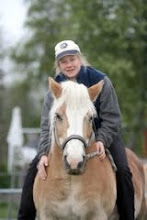The stallion 249 Folie, who was registered as an arab
halfbred, is considered the foundation sire of the haflinger breed.
Folie was born in 1874 in the South Tyrolean village of Schluderns in
Vinschgau with a farmer named Josef Folie, and was bought as a weanling
by the stallion-keeper and breeder köptes Rochus Eberhöfer. Folie was
the son of an Oriental halfbred stallion, 133 El' Bedavi XXII and a
noble South Tyrolean local bred mare of galician ancestry. Folie was a
golden chestnut with a star, four white feet and a dorsal stripe. He was
described as the ideal pack horse, with the nobility of the arab,
well-muscled with a good sloping shoulder, strong top line, a horizontal
croup, strong and well defined joints and ground-covering gaits. Folie
had a wither's height of approximately 148 cm (58.3'') chest
circumference 182 cm (71.7'') and canon bone circumference 20.5 cm
(8.1'').
Folie got three sons approved for breeding: 37
Laas, born in 1896, 14 Folie I, born in 1887 and liz./252/233 Hafling,
born in 1897. The better of the three was Laas, who according to
descriptions of that time was a carbon copy of his sire, but
unfortunately he was sterile after a testicle infection and was sold as a
riding horse to the army already after two breeding seasons and didn't
throw any approved sons. Six of the seven purebred haflinger stallion
lines present in the haflinger breed today descend from 14 Folie I: A,
B, M, N, S och St. His measurements were 146-170-20 and he was a light
chestnut with a dorsal stripe and lots of white markings. Hafling's
measurements were 141-169-20 and he was a small, noble dark chestnut
with a blaze and a lively temperament, undefined withers and
ground-covering gaits.
The first governmet-owned stallion to be registered as a haflinger was 229 Folie II, a dark bay stallion, son of 14 Folie I.
The seven stallion lines were founded by the following stallions:
A-line: 999 Anselmo (originaly Hansele),
born in 1926. Anselmo was a relatively coarse, very broad and deep
stallion with a lively temperament. He was a chestnut with light mane
and tail, a broad blaze and a white lower lip. At the age of 28 he still
showed a 85% fertility! Measurements: 139-180-21.
B-line: Bolzano,
named after a South Tyrolean village, was born in 1915. He was a
dappled chestnut with an irregular blaze, snip and dorsal stripe plus a
Ben d'Or on his left shoulder. Measurements: 144-184-22.
M-line: Massimo, born in 1927. Massimo was described as nobel and typical of the breed.
N-line: Nibbio (originaly Niggl 2),
born in 1920. He showed good offspring and was a golden chestnut with a
broad blaze, white lower lip and white pasterns on both hind legs.
Nibbio often passed on his white markings to his offspring.
Measurements: 135-183-19.
The stallion Nibbio (Niggl 2) is on the cover of the Swedish edition of Libro delle Origini della Razza Avelignese by Pietro de Paoli.
S-line: Stelvio,
who like Bolzano got his name from a South Tyrolean village, was born
in 1923. Stelvio was a chestnut with light mane and tail, bald face,
white hind legs and a Ben d'Or on the right side of his croup.
Measurements: 140-178-20.
St-line: 1074 Student,
born in 1927. Student was a roaned chestnut with a blaze and a white
pastern on his left hind leg. Measurements: 143-183-20,7.
1074 Student. Photo: Private.
W-line: 401/liz. Willi,
born in 1921. Chestnut with blaze and light legs. Passed on a massive
but noble type of haflinger. Measurements: 142-170-20,3.
Except these "pure" stallion lines there are also:
The C-line, founded by the German stallion Caro As. Caro As, which in German means Ace of Diamonds, had 25% arab blood.
The D-linjen, founded by the German stallion
Nasir. Nasir had 25% arab blood, and his offspring got names beginning
with a D, to distinguish them from "general" N-line-haflingers.
The F-line, founded by the Austrian stallion liz.
Freiherr, who also had 25% arab blood. Liz. Freiherrwas only used for
breeding a few years, before he and his offspring was removed from the
breeding pool, but his offspring is still present in some countries.
The G-line, founded by the East German arab thoroughbred Galib ben Afas ox.
I mention these stallion lines, so that breeder's may be aware that they have arab blood in them.
Haflinger stallions get a name that begins with
the same letter as the name of their sire. In that way the breeders keep
track of which line a certain stallion belongs to. Please observe that there are also stallions with arab blood on their dam's side and purebred haflinger stallions with a name that starts with C, D, G or F. The mares most often
get the same initial letter as their dams. In some German provinces
also the mares get the same initial letter as their sire. I Italien
every year has it's own letter, so that a certain year all mare names
begin with an A, the next year with a B etc. etc. Earlier this system
was used also when naming haflinger stallions in Italy. An Italian
N-line stallion who in this got a name beginning with an H (Hofmeister,
born in 1956) was sold to Germany, and his sons got names that begun
with an H as well. In this way the H-line, which really is a branch of
the N-line, was "born".
On this site, I will present stallions from the different lines, but they will be presented as individuals who, thanks to their offspring, has put a "stamp" on the breed.
(c) Kerstin Dreborg 2015



How can I determine which line my Haflinger is, if I can see 4 out of 7 "big stallions" among his ancestors?
SvaraRadera